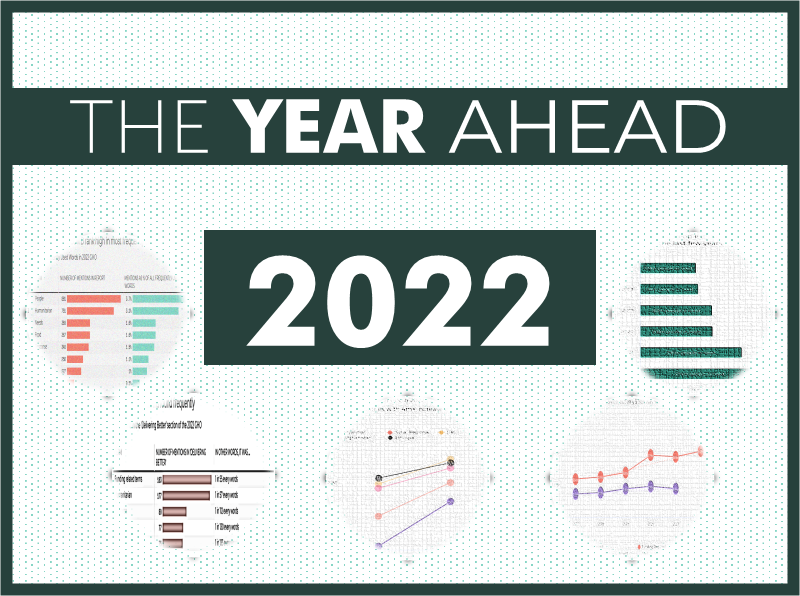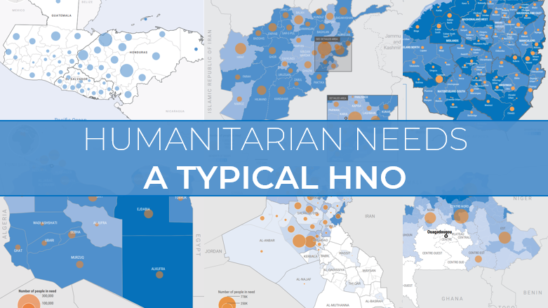
The Humanitarian Year Ahead: 2022 in 5 Charts6 min read
How many pages is too many for a report? 304 pages? That’s the length of the 2022 Global Humanitarian Overview (GHO) that outlines humanitarian needs going into the next year. It’s full of data and trends, and hints at what the year ahead will bring. What we’ve done is read the report, pulled out the data, and produced the graphs that will illuminate what the next year will bring.
We thoroughly recommend diving into the report, though. It’ll provide you with updates on individual contexts, and deep dive into trends that shape the humanitarian sphere. In the meantime, here are the five key things in the report that caught our eye.
The Three Cs – Conflict, Climate and COVID
Conflict, climate and COVID stand out as the three big factors driving and shaping humanitarian response. We looked at the most frequently used words, which in this instance we defined as any word used over 30 times (excluding pronouns, numbers, and other common language building blocks). COVID and Conflict both made the top 20 words, and climate wasn’t far behind either. In fact, over 1 in 100 words was one of these three. It might even be more if we filtered out all the ‘common language building blocks’ – but we didn’t have time to go through over 6,300 unique words).
These factors drive many of the global trends that were highlighted in the GHO. COVID led to school closures, economic disruption, and healthcare systems. Conflict and climate events led to greater levels of displacement, with the number of IDPs reaching 48 million in 2020. Hunger also increased, again driven in part by the pandemic and climate events. Sure, it’s more complex than just this, but the three Cs will continue to drive more people in need in 2022.
Accelerating Needs
The graph below shows the trend clearly, but no visual will capture the situation as boldly as the GHO does in this sentence: “1 in 29 people worldwide needs help, which is yet another significant increase from 1 in 33 in 2020 and 1 in 45 in 2019”. The number of people in need has doubled in 5 years, from 134 million people in 2018, to 274 million people in 2022.
Below the surface we see tremendous churn as well. On the one hand, the number of people in need has increased hugely in Myanmar, DRC, Ethiopia and Afghanistan, and in the regional crisis of Syria. Reasons behind these large increases include: conflict, climate and covid, tough economic conditions, and rises in food insecurity. On the other hand, Niger, Burundi, Libya, Iraq and the regional Horn of Africa/Yemen crises have seen decreases in the number in need.
Donors asked to keep up with a runaway train
From 2017 to 2021, donors have put in over $84bn to humanitarian responses, and that’s not even including the funding that is ‘outside of a response plan’. But $153bn was needed over that same period.
The requirement in 2022 is a huge $41bn, but with only $17bn received in 2021 (as of early December), there’s no real chance of reaching this number. And it’s not as if the gap is closing. Funding required increased 13% year-on-year over the most recent five year period (2018-2022). But funding received only increased by 5% year-on-year over the most recent five year period (2017-2021).
We recommend switching off the ‘funding received’ and ‘funding required’ data from the graph above by clicking on both of them in the legend. This will show the year-on-year growth rates of each, and the growing gap between the two is even clearer to see.
The gap is widening year-on-year. Donors are being asked to keep up, but the funding needed is spiralling out of control.
Fund more, fund better, or change better
The last section of the report looks at “delivering better”. In other words, what are the things we should be focusing on to improve the processes and ways of working behind humanitarian operations? Upon first inspection, it comes across as a big list of 12 disparate things competing for our attention – everything from ‘anticipatory action’ to ‘data responsibility’. But in reality, the system changes that are highlighted fall into three categories.
The first of these is “fund more”. This includes getting more funding for: the mitigation and prevention of GBV, accountability to affected populations and PSEA, and preventing famine.
The second of these is “fund better”. This includes: delivery of core work and cross-cutting issues through the use of ‘pooled funds’, financing local actors, and pre-financing anticipatory action.
And the last of these is “change better”. This includes: the centrality of protection, analysis of needs jointly across sectors (JIAF), reviewing costing methodology of response plans, ‘operationalising the nexus’, and strengthening data management.
The big focus on funding is reflected in the fact that 1 in 55 words in this section of the report are funding-related (e.g. fund, funding, CBPF etc.). The table above is not a fair comparison in reality, as we’ve compared any terms that are funding-related to single terms (i.e. not grouped together). So the correct reading is not that this section prioritises funding over people. The correct reading is that funding is mentioned very often. This speaks to the fact that the humanitarian system is in a constant state of advocacy for ‘more’ or ‘better’ funding, But the categories above also show how there are so many competing priorities lumped into this, and people have limited attention. At the end of the day, is anyone going to read the 51 pages that outline these competing priorities?
A fraction of a fraction
The last thing that caught our eye was the number of people reached in 2021. This is the sixth chart on the page (the headline was still right, though, as we’re looking at 2021 in this section). Looking at country plans, 107 million people were reached in 2021. That’s a huge number. But it’s obviously a fraction of those targeted, which was 153 million people. Which is also a fraction of those actually in need, which was 223 million people.
The framing of this in the report is that a total of 70% of those targeted were reached. But this ignores the people in need who weren’t targeted – roughly 3 in every 10 people in need. And sure, many things might have contributed to people not being targeted: access constraints, other actors delivering, or a lack of capacity in the humanitarian community, to mention just a few things. But let’s not forget about those who weren’t targeted. The framing is a fraction of a fraction – we’ve already excluded people in our reported number.
In reality, the percentage reached of those in need was 48%, and we should be upfront in saying that. Those people in need still exist, even if we aren’t targeting them, so let’s give visibility to them.
Methodology and Sources
PIN: 2017-2021 numbers from 2021 GHO. 2022 GHO number from 2022 GHO.
Target: 2017-2021 numbers from GHO in each respective year
Reached: 2021 numbers from 2022 GHO
Requirement: 2017-2021 numbers from FTS. 2022 from 2022 GHO – extracted 4th December
Received: all numbers from FTS – extracted 4th December
Population: World Population Prospects 2019 (2017-2020 estimates; 2021 onwards Medium Variant)
Most frequently used words (as in the first section looking at the three Cs) were determined by examining all text in the GHO (except visuals, such as graphs). Common ‘building block’ words, such as ‘in’, ‘with’, ‘and’ etc. were excluded from the analysis. All ‘building block’ words found over 30 times were filtered. “Mentions as a % of all frequently used words” defines ‘frequently used words’ as any word found over 30 times in the report – excluding the common building block words.
‘Funding related terms’ in the Fund more… section are: fund, funds, funding, finance, financing, financial, cerf, cbpf, cbpfs.
The chart in the ‘fraction of a fraction’ section refers to the number of people in need, targeted and reached in the country specific plans noted in the 2022 GHO on page 14.


